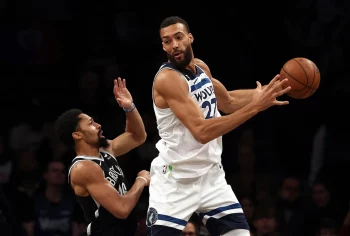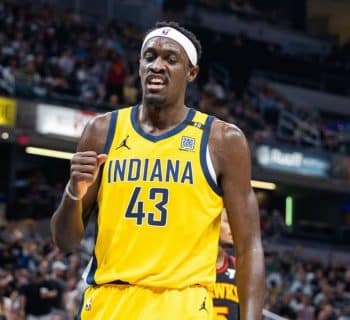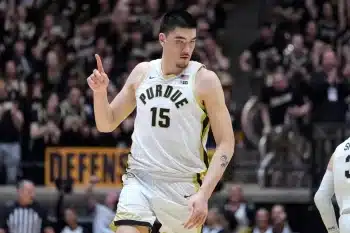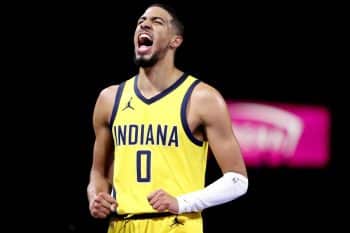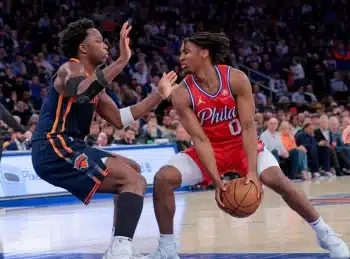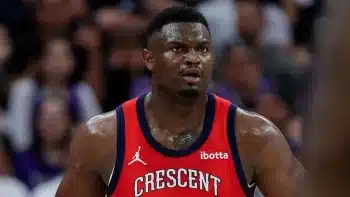NBA
Quin Snyder: On Process, Patience And How An Elite Defense is Built

“I don’t think people realize how intelligent he is. His basketball IQ is on a different level.” –Paul Millsap, on Utah Jazz head coach Quin Snyder
The first thing you notice about Quin Snyder in person is his stare. What’s often a piercing glare to a player or referee on the floor is a more refined look in the confines of the press room, but it’s engaging and almost hypnotic nonetheless. He doesn’t make eye contact just for the sake of politeness. This is a man who, in almost every circumstance while on the job, knows more about what you’re saying than you do, but you’d never know it. No thought is too abstract, no question too elementary that Snyder gives it anything less than his full attention. He does the same thing on the basketball court – it’s why the Jazz hired him.
Snyder never speaks in absolutes. His approach to coaching is methodical and highly contextualized, capturing the entire picture while retaining a keen eye for even the minutest detail. You’ve never “failed” in his system – rather you’ve yet to improve, yet to embrace what’s often a painstaking process; you’ve never fully “perfected” anything so much as you’ve progressed to a higher level of functionality.
Snyder’s outlook is born of decades of experience across a wide range of basketball philosophies. He began at Duke under Mike Krzyzewski, developing the mindset of a winner, albeit one able to be so despite ever-changing circumstances. He graduated to the head job at Missouri, where he saw firsthand the whirlwind of hype, success, turbulence and – eventually – even failure. He spent years in the San Antonio Spurs organization as head coach of their D-League affiliate Austin Toros, learning patience and a grounded, logic-based approach from the model franchise in competitive team sports. Stops as an assistant for multiple other NBA teams, plus invaluable time under European legend Ettore Messina, rounded out his influences before arriving in Utah.
His varied experience preceding his first appointment to a top job in the world’s most elite league gave him perspective, not only within himself but with what separates his newest position from those in his past. It’s part of why Snyder’s opinion on what makes the NBA so different likely varies from what most popular consensus would be.
“I think the capacity that the players have to develop and learn, the speed with which they can pick things up,” Snyder told Basketball Insiders in a sit-down interview. “People perceive talent as athleticism and size and strength, [but] a lot of the ‘talent’ that these guys have is their ability to learn quickly. Show them something, they can do it immediately.”
This process is one Snyder set to work on straight away upon his arrival in Utah. In many ways, it mirrored his own road to where he is now – a group of guys who in several cases, just like Quin, are still adjusting to the highest level. The new scheme he brought with him was at times tough to implement as a result, and it presented tactical challenges along with broader themes of approach.
“The biggest [challenge] offensively is spacing,” Snyder said. “When you’re the best player on the floor, sometimes it doesn’t matter where you are as much. People have to kind of react to you. And now you’re in a situation where there’s people with equal or more ability than you on the offensive end, and [you’re figuring] out how you need to space to help them, and also to help yourself to facilitate high percentage offense.”
Unlike a fellow rookie head coach in Golden State’s Steve Kerr, Snyder wasn’t bequeathed MVP-level offensive talent that just needed a few tweaks from a narrow-minded predecessor to fully blossom. He was given the makings of a competent offense personnel-wise, but with so much youth and relative inexperience that a learning curve was a foregone conclusion. But while his team’s accomplishments on this end have been dwarfed this year by those on the defensive side of the ball, it’s easy to forget that Snyder has succeeded in progressing his group along their developmental timetable here as well. The Jazz were the league’s 25th-ranked per-possession offense last season, but came out of the gate this year as roughly a league average squad and have remained one virtually all year long despite multiple injuries to rotation players and some personnel shake-ups midway through the year.
Snyder doesn’t run contrary to public perception all the time, of course – only when it suits his team’s progression. And just like nearly everyone else in this case, he’d prefer to talk about their defense.
“I went into the year wondering how aggressive we were capable of being.”
Snyder had nowhere to go but up defensively. The Jazz were the league’s worst per-possession defense last season, with an ill-fitting scheme and a vast lack of the type of cohesiveness that defines the league’s stingier units. Quin set straight to work, identifying the largest issue immediately.
“I think pick-and-roll defense, for our group [was the biggest hurdle],” Snyder said. “Even the guys that have been here, the scheme is very different, so there’s a learning process that you go through when you’re implementing a defensive system too. And that’s such an important part of defense now in the NBA that it took some time – and not just on the ball.”
This last nugget is vital. The first step in fixing Utah’s sieve-like defense against the league’s most common and effective play type was pushing his young group to the realization that, despite there only being two players directly involved in the action, it takes all five on the court to properly defend it.
“People got to the rim a lot on us,” he said. “We were trying to play pick-and-roll basically two-on-two…and the other guys were watching and clapping, and not clapping a whole lot because it wasn’t very good.”
What he means can be expressed visually. Take a look at where the Jazz were early on in the year, and note in particular where the players not involved in the actual pick-and-roll action are located:
For those who didn’t quite catch it, a couple stills to illustrate the way Utah’s help defenders were consistently a beat or two behind on their rotations, costing the Jazz easy buckets:
As he mentioned, part of the issue was the group’s adjustment to Snyder’s new scheme. Where former Jazz coach Ty Corbin had Utah’s bigs leap out and “hedge” opposing ball-handlers (often leaving the Jazz in a four-on-three against if the handler was able to thread a pass through the trap), Snyder saw a different fit for his personnel – one that depended in part on each player’s individual attributes.
“We do both now – it depends a little bit game to game, it depends on personnel,” he said. “Rudy Gobert is different than Trevor Booker, where Rudy is back more, Trevor’s up because he’s more aggressive. He’s 6’6 and athletic, Rudy’s long and athletic. I think just adjusting to what we have. Dante [Exum] is different in pick-and-roll than Trey [Burke]. So trying to take advantage of some of those various strengths and weaknesses.”
And slowly but surely, his group began to pick up the finer points. Help reads on opposing two-man action became more a matter of instinct and reflex than of a conscious thought process. Compare the following play to those above:
Look at how early Gobert, who isn’t involved in the initial two-man action, recognizes that Burke has dropped behind Zach LaVine by a step and moves to impede his path.
A beat or two is a huge deal, even to someone as lengthy and rangy as Gobert. It’s easy to see how Snyder’s emphasis on off-ball involvement defensively – something his group “spent a lot of time drilling,” he told me – has become ingrained in Utah’s defenders, to the point where easy layups in November have turned into a ball-handler running smack dab into one of the league’s most imposing rim protectors and turning the ball over in his haste to avoid being swatted into the second row.
Another part of this development over time was the layering of complex skills over simpler ones, something Snyder has talked about at length in the past and expanded upon during our sit-down.
“The layers I would probably characterize as situations. We’re basically simulating,” Snyder said, before going into full-on coach-speak. “The easiest example would be sideline pick-and-roll versus middle pick-and-roll, versus Chris Paul and Blake Griffin [running] pick-and-roll in the low post; one-four pick-and-roll versus one-five pick-and-roll. There’s certain players that people specifically will put in pick-and-roll – that happened to us earlier in the year a lot, where people identified a player that they think is not as good defensively and isolate them. So learning how to manage those situations and trying to recreate a specific P&R situation.”
And as his team has seen more and more individual scenarios, they’ve slowly developed into a cohesive, terrifying five-man unit capable of reading and reacting to any opponent action with a combination of precision and force. Utah’s pick-and-roll defense last season was among the worst in the NBA, per Synergy Sports, particularly against roll men in Corbin’s trapping scheme, to whom the Jazz allowed a gross 51.5 percent shooting. They were 27th for per-possession efficiency allowed to roll men, and 26th against pick-and-roll ball-handlers.
This year, with much of the same personnel? They’re 12th against ball-handlers, and third overall versus opposing roll men, cutting that ugly 51.5 percent figure down to 42.1 percent, second only to the Chicago Bulls on the season. Snyder’s scheme has allowed guys like Gobert and Derrick Favors to drop back and cut off easy passes to the cutting dive man. And while Corbin’s system may have been intended to cause more turnovers from the ball-handler by trapping him up high, Snyder’s has actually done a better job of this – the Jazz are forcing a significantly higher percentage of opponent turnovers in pick-and-roll sets while playing a more conservative style, a nod to just how much better the fit is.
The trickle-down has reached other elements of Utah’s defense, of course. Snyder’s theme of layering in skills applies here also; as the Jazz have grown comfortable against more common actions like pick-and-roll, their ability to properly combat other sets and counters has been freed up. With a foundation in place, he can spend time in practice on a nuanced variation or a particularly difficult opposing player without worrying that his group will lose those vital fundamentals.
Nowhere is the evidence of the efficacy of this process more visible than in Utah’s team-wide defensive progression throughout the year. Through November, the Jazz were 28th in per-possession defensive efficiency, ahead of only the hapless Los Angeles Lakers and Minnesota Timberwolves. They climbed to 25th for December, then took a big leap to 16th in January as the group truly began to put things together. For February, they were mere decimals behind Milwaukee for the league’s best defense. And since a trade deadline deal sending Enes Kanter – the object of much of the specific opponent targeting Snyder mentioned above – to Oklahoma City, the Jazz have occupied the top spot by a considerable margin. They’re over five points per-100-possessions better than second-place Golden State in that 25-game span, posting a 93.5 figure that would be easily the best over any full season since 1996, the earliest for which NBA.com makes that stat available.
This isn’t all Snyder, of course, something he’d be the first to admit. Gobert’s ascension to among the league’s premier defenders is more than just coaching, as is the resulting effect on Favors and the rest of the team. The Jazz have quietly seen excellent contributions from less heralded wings like Elijah Millsap and Rodney Hood, this on top of rookie Exum wildly outperforming his pre-draft expectations defensively.
At the same time, it’s impossible to view any of these individual developments without giving major credit to the person who allowed it all to be possible. Snyder’s fingerprints are all over each of these cases, from his work with Gobert offensively to ensure the Frenchman can stay on the court for big minutes to his empowering of Hood on both ends of the floor despite a year marred by injuries. The Jazz are among the toasts of the league over the latter half of the season, and there’s no way to frame this conversation without featuring Snyder prominently.
But true to form, he’ll come nowhere close to labeling his team’s season-long progress as a final success. There are still steps to be taken, holes to be filled. He drills his team hard in practice. Perfection isn’t realistic, and mistakes are not only anticipated but almost encouraged; what is expected, however, is that fixable mistakes not be repeated.
In Snyder, the Jazz have their coach for the revitalization of a once-great franchise. Next year will mark the point at which results are expected to match hype – but don’t tell him that. What’s important to Snyder is doing the most possible each day, each practice, each game. If he’s learned one thing in his time throughout the coaching ranks, it’s that process will yield results if the dedicated commitment to it is present from his entire group.
“Just to help them is my job,” he told me as our sit-down finished up. “And just put them in situations where hopefully they can be successful.”
He’s well on his way. No doubt his players see the same thing as those of us laymen fortunate enough to share the room with him: The same engaging look, the idea that no question or concern could ever be too inconsequential. They’d better get used to the occasional death stare, as well – neither those, nor Snyder, is going anywhere anytime soon.



